Properties
| Storage Buffer | PBS pH7.4, 50% glycerol, 0.09% sodium azide *Storage buffer may change when conjugated |
| Storage Temperature | -20ºC, Conjugated antibodies should be stored according to the product label |
| Shipping Temperature | Blue Ice or 4ºC |
| Purification | Affinity Purified |
| Clonality | Polyclonal |
| Specificity | Detects ~22kDa. Does not cross-react with αA-crystallin. |
| Cite This Product | StressMarq Biosciences Cat# SPC-126, RRID: AB_2084306 |
| Certificate of Analysis | A 1:5000 dilution of SPC-126 was sufficient for detection of alpha B crystallin in 20 µg of HeLa cell lysate by ECL immunoblot analysis. |
Biological Description
| Alternative Names | AACRYA Antibody, Alpha crystallin B chain Antibody, CRYA2 Antibody, CRYAB Antibody, CTPP2 Antibody, HSPB5 Antibody, NY REN 27 antigen Antibody |
| Research Areas | Cancer, Cell Signaling, Chaperone Proteins, Heat Shock, Neuroscience, Protein Trafficking |
| Cellular Localization | Cytoplasm, Nucleus |
| Accession Number | NP_001876.1 |
| Gene ID | 1410 |
| Swiss Prot | P02511 |
| Scientific Background | The alpha-crystallins are major water-soluble lens structural proteins of the vertebrate eye that are related to the small heat shock protein family. The alpha-crystallins possess structural and functional similarities with HSP25 and HSP27 (1). Mammalian lens cystallins are divided into alpha, beta and gamma families. Alpha and beta families are further divided into acidic and basic groups (Alpha-A and Alpha-B respectively). In the lens, alpha-crystallin primarily functions to maintain proper refractive index, however it can also function as a molecular chaperone that binds to the denatured proteins, keeping them in solution and thereby maintaining the translucency of the lens. When cellular stress occurs, alpha-crystallin enters its' phosphorylated state and may serve a structural control function and play a role in protein maintenance (2). In addition to their interaction with proteins, alpha-crystallins also interact with native molecules such as membrane proteins, Golgi matrix protein, structural proteins, nuclear proteins and DNA (3, 4, 5, 6, and 7). Two other functions are an autokinase activity and participation in the intracellular architecture, and it has also been proven that both alpha-A and B prevent apoptosis by inhibiting caspases (8). Specifically, alpha-B cystallin is found in many cells and organs outside the lens, and alpha B is overexpressed in several neurological disorders and in cell lines under stress conditions (9). |
| References |
1. Merck K.B. et al. (1993) J Biol Chem. 268: 1046-1052. 2. Horwitz J. (1992) Proc Natl Acad Sci USA 89(21): 10449-10453. 3. Cobb B.A. and Petrash J.M. (2002) Biochemistry. 41: 483-490 4. Horwitz J. (2003) Exp Eye Res. 76: 145-153. 5. Bullard B. et al. (2004) J Biol Chem. 279: 7917-7924. 6. Gangalum R.K., Schibler M.J. and Bhat S.P. (2004) J Biol Chem. 279: 43374.43377. 7. Maddala R. and Rao V.P. (2005) Exp Cell Res. 306: 203-215. 8. Yaung J., et al. (2007) Molecular Vision 13: 566-577. 9. Head M.W. et al. (2000) Neuropathol Appl Neurobiol. 26: 304-312. |
Product Images

Immunocytochemistry/Immunofluorescence analysis using Rabbit Anti-Alpha B Crystallin Polyclonal Antibody (SPC-126). Tissue: Heat Shocked Cervical cancer cell line (HeLa). Species: Human. Fixation: 2% Formaldehyde for 20 min at RT. Primary Antibody: Rabbit Anti-Alpha B Crystallin Polyclonal Antibody (SPC-126) at 1:120 for 12 hours at 4°C. Secondary Antibody: APC Goat Anti-Rabbit (red) at 1:200 for 2 hours at RT. Counterstain: DAPI (blue) nuclear stain at 1:40000 for 2 hours at RT. Localization: Actin filament bundles. Nuclear splicing speckles. Exosomes. Magnification: 100x. (A) DAPI (blue) nuclear stain. (B) Anti-Alpha B Crystallin Antibody. (C) Composite. Heat Shocked at 42°C for 1h.

Immunocytochemistry/Immunofluorescence analysis using Rabbit Anti-Alpha B Crystallin Polyclonal Antibody (SPC-126). Tissue: Heat Shocked Cervical cancer cell line (HeLa). Species: Human. Fixation: 2% Formaldehyde for 20 min at RT. Primary Antibody: Rabbit Anti-Alpha B Crystallin Polyclonal Antibody (SPC-126) at 1:120 for 12 hours at 4°C. Secondary Antibody: FITC Goat Anti-Rabbit (green) at 1:200 for 2 hours at RT. Counterstain: DAPI (blue) nuclear stain at 1:40000 for 2 hours at RT. Localization: Actin filament bundles. Nuclear splicing speckles. Exosomes. Magnification: 20x. (A) DAPI (blue) nuclear stain. (B) Anti-Alpha B Crystallin Antibody. (C) Composite. Heat Shocked at 42°C for 1h.
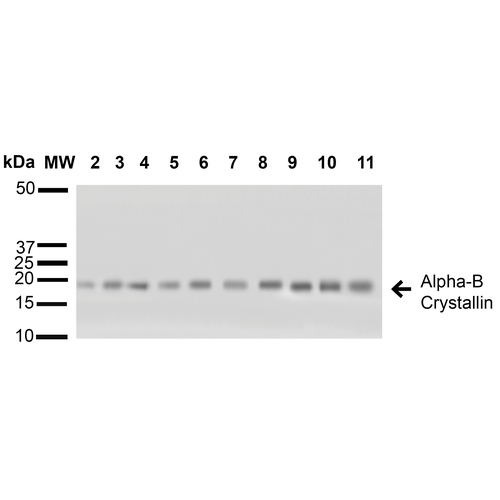
Western blot analysis of Human A431, HCT116, HeLa, HepG2, HEK293, HUVEC, Jurkat, MCF7, PC3 and T98G cell lysates showing detection of ~22 kDa Alpha B Crystallin protein using Rabbit Anti-Alpha B Crystallin Polyclonal Antibody (SPC-126). Lane 1: Molecular Weight Ladder (MW). Lane 2: A431 cell lysates. Lane 3: HCT116 cell lysates. Lane 4: HeLa cell lysates. Lane 5: HepG2 cell lysates. Lane 6: HEK293 cell lysates. Lane 7: HUVEC cell lysates. Lane 8: Jurkat cell lysates. Lane 9: MCF7 cell lysates. Lane 10: PC3 cell lysates. Lane 11: T98G cell lysates. Load: 15 µg. Block: 5% Skim Milk in 1X TBST. Primary Antibody: Rabbit Anti-Alpha B Crystallin Polyclonal Antibody (SPC-126) at 1:1000 for 60 min at RT. Secondary Antibody: Goat Anti-Rabbit IgG: HRP at 1:1000 for 60 min at RT. Color Development: ECL solution for 6 min in RT. Predicted/Observed Size: ~22 kDa.
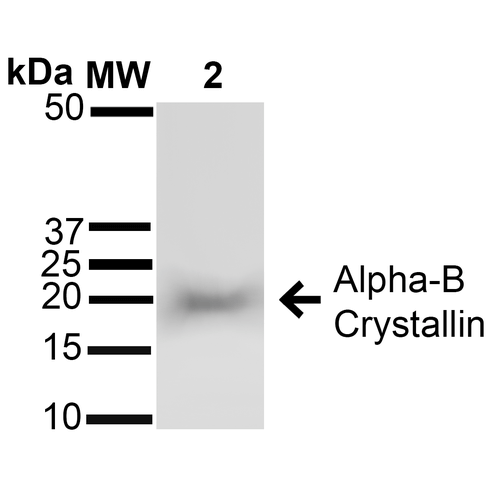
Western blot analysis of Rat Brain cell lysates showing detection of ~22 kDa Alpha B Crystallin protein using Rabbit Anti-Alpha B Crystallin Polyclonal Antibody (SPC-126). Lane 1: Molecular Weight Ladder (MW). Lane 2: Rat Brain cell lysates. Load: 15 µg. Block: 5% Skim Milk in 1X TBST. Primary Antibody: Rabbit Anti-Alpha B Crystallin Polyclonal Antibody (SPC-126) at 1:1000 for 60 min at RT. Secondary Antibody: Goat Anti-Rabbit IgG: HRP at 1:1000 for 60 min at RT. Color Development: ECL solution for 6 min in RT. Predicted/Observed Size: ~22 kDa.

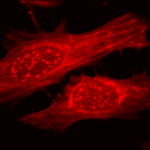
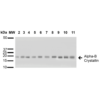
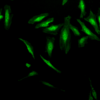
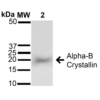




















StressMarq Biosciences :
Based on validation through cited publications.